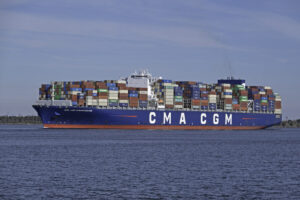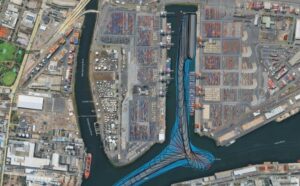APM Terminals is addressing the issue of air pollution by releasing version 2.0 of its ‘Leading Safety’ App this year.
Employees at each of its 74 terminals and more than 100 inland service depots will have access to a function to raise awareness about air quality and its impacts on the app as well as informative features on health, safety, and environmental management.
Air pollution continues to rank as the single biggest threat to human health according to the World Health Organisation.
The Leading Safety App also has functionalities for non-employees, including real-time, local, air-quality data and advice.
If local air quality is poor, external truck drivers may be instructed through the app to switch-off their vehicle’s engine whilst queueing to enter the terminal.
It also advises maintenance contractors about whether they should limit their time outside.
The main air pollutants that contribute to air pollution are microscopic solid or liquid particulates from carbon monoxide, sulphur dioxide, nitrogen dioxide and ground-level ozone.
Each one comes from a different source, has different effects on health, and different chemical behaviours.
APM Terminals’ Leading Safety App (pictured above) uses a colour-coded Air Quality Index (AQI) developed by the US Environmental Protection Agency (US EPA).
The Index translates pollutant concentration measurements into one easy-to-understand scale from one – ‘Good’, meaning that there are no health risks, to six – ‘Hazardous’, which indicates that there is a serious risk of respiratory effects.
Read the latest Port Technology technical paper from the International Chamber of Shipping on the recent GHG strategy from the IMO
This allows personnel to manage exposure times transparently based on the information to keep people safe and healthy.
APM Terminals is at the start of a journey to address air pollution and carbon emissions at a number of its locations.
It is doing this using electric and hybrid container handling equipment (CHE) and using renewable energy supplies.
Examples include solar installations in Uruguay and India, and electric CHE using 100% renewable energy in Rotterdam.
Ashley Woods, Senior Environmental Advisor at APM Terminals, said: “There is a balance to be made.
“Electrification of diesel equipment can help improve local ambient air quality, but in a country which relies on coal in their energy mix, this will increase CO2 emissions and negatively affect air quality in other areas.
“When it comes to environmental impacts we need to look at the bigger picture and make the right decisions in the right locations across our portfolio.
“One size does not fit all.
“As a company we’re looking at different scenarios to reduce our emissions of air pollutants and Greenhouse Gas Emissions globally, to ensure our future decisions have the most beneficial impact.
“While we’re finalizing our global approach, raising awareness internally and externally is key to gaining acceptance.”
Read more:
-
The American Bureau of Shipping has issued a new advisory on marine oil to help the industry prepare for the IMO’s 2020 global sulphur cap
-
The International Chamber of Shipping has warned of “chaos and confusion” unless the IMO urgently resolves issues with implementing the 0.5% sulphur in marine fuel cap











